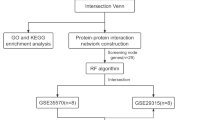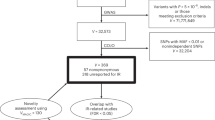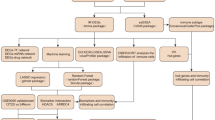Abstract
Hashimoto’s disease (HD) is one of the major clinical subtypes of autoimmune thyroid disease. Both environmental and genetic factors contribute to the pathogenesis of HD. Previous evidence has shown that both IRAK2 and TLR10 are potential candidate susceptibility genes for HD. In this study, a total of 3654 Chinese women, including 973 HD cases and 2681 healthy controls, were recruited. Thirty-three tag single nucleotide polymorphisms (SNPs) in IRAK2 and TLR10 were genotyped. Genetic association analyses at both the single-marker and haplotype levels were performed. Gene-by-gene interaction analyses were also conducted in case-only samples, as well as eQTL analyses for significant SNPs based on data extracted from the GTEx database. We identified that two SNPs, rs165501 (OR = 1.20, P = 0.0008, IRAK2) and rs10004195 (OR = 1.23, P = 0.0001, TLR10), were identified to be significantly associated with HD. Rs10004195 was significantly associated with the gene expression of TLR10 in human pituitary tissues (P = 2.00 × 10−4), while rs165501 was significantly associated with the expression of IRAK2 in human thyroid tissues (P = 3.10 × 10−6). No significant results were obtained in the gene-by-gene interaction analyses. Our findings suggest that both IRAK2 and TLR10 play important roles in the onset and development of HD.
Similar content being viewed by others
Log in or create a free account to read this content
Gain free access to this article, as well as selected content from this journal and more on nature.com
or
References
Brown RS. Autoimmune thyroid disease: unlocking a complex puzzle. Curr Opin Pediatr. 2009;21:523–8.
Pyzik A, Grywalska E, Matyjaszek-Matuszek B, Roliński J. Immune disorders in Hashimoto’s thyroiditis: what do we know so far? J Immunol Res. 2015;2015:979167.
Pearce EN, Farwell AP, Braverman LE. Thyroiditis. N Engl J Med. 2003;348:2646–55.
Noureldine SI. Tufano RPAssociation of Hashimoto’s thyroiditis and thyroid cancer. Curr Opin Oncol. 2015;27:21–5.
Chistiakov DA. Immunogenetics of Hashimoto’s thyroiditis. J Autoimmune Dis. 2005;2:1–21.
Kavvoura FK, Akamizu T, Awata T, Ban Y, Chistiakov DA, Frydecka I, et al. Cytotoxic T-lymphocyte associated antigen 4 gene polymorphisms and autoimmune thyroid disease: a meta-analysis. J Clin Endocrinol Metab. 2007;92:3162–70.
Wiersinga WM. Clinical relevance of environmental factors in the pathogenesis of autoimmune thyroid disease. Endocrinol Metab. 2016;31:213–22.
Chen G, Guan F, Lin H, Li L, Fu D. Genetic analysis of common variants in the HDAC2 gene with schizophrenia susceptibility in Han Chinese. J Hum Genet. 2015;60:479–84.
Guan F, Li L, Qiao C, Chen G, Yan T, Li T, et al. Evaluation of genetic susceptibility of common variants in CACNA1D with schizophrenia in Han Chinese. Sci Rep. 2015;5:12935.
Guan F, Niu Y, Zhang T, Liu S, Ma L, Qi T, et al. Two-stage association study to identify the genetic susceptibility of a novel common variant of rs2075290 in ZPR1 to type 2 diabetes. Sci Rep. 2015;6:29586.
Guan F, Wei S, Feng J, Zhang C, Xing B, Zhang H, et al. Association study of a new schizophrenia susceptibility locus of 10q24.32-33 in a Han Chinese population. Schizophr Res. 2012;138:63–8.
Guan F, Wei S, Zhang C, Zhang H, Zhang B, Xing B, et al. A population-based association study of 2q32.3 and 8q21.3 loci with schizophrenia in Han Chinese. J Psychiatr Res. 2012;47:712–7.
Guan F, Zhang B, Yan T, Li L, Liu F, Li T, et al. MIR137 gene and target gene CACNA1C of miR-137 contribute to schizophrenia susceptibility in Han Chinese. Schizophr Res. 2014;152:97–104.
Guan F, Zhang C, Wei S, Zhang H, Gong X, Feng J, et al. Association of PDE4B polymorphisms and schizophrenia in Northwestern Han Chinese. Hum Genet. 2012;131:1047–56.
Barić A, Brčić L, Gračan S, Torlak Lovrić V, Gunjača I, Šimunac M, et al. Association of established hypothyroidism-associated genetic variants with Hashimoto’s thyroiditis. J Endocrinol Invest. 2017;40:1061–7.
Cho WK, Jang JP, Choi EJ, Jeon YJ, Jung IA, Kim SH, et al. Association of Toll-Like Receptor 10 polymorphisms with autoimmune thyroid disease in Korean children. Thyroid. 2014;25:250–6.
Peng S, Li C, Wang X, Liu X, Han C, Jin T, et al. Increased toll-like receptors activity and TLR ligands in patients with autoimmune thyroid diseases. Front Immunol. 2016;7:578.
Hess NJ, Jiang S, Li X, Guan Y, Tapping RI. TLR10 is a B cell intrinsic suppressor of adaptive immune responses. J Immunol. 2017;198:699–707.
Sun J, Wiklund F, Hsu FC, Bälter K, Zheng SL, Johansson JE, et al. Interactions of sequence variants in interleukin-1 receptor-associated kinase4 and the Toll-like receptor 6-1-10 gene cluster increase prostate cancer risk. Cancer Epidemiol Biomark Prev. 2006;15:480–5.
Lazarus R, Raby BA, Lange C, Silverman EK, Kwiatkowski DJ, Vercelli D, et al. TOLL-like receptor 10 genetic variation is associated with asthma in two independent samples. Am J Respir Crit Care Med. 2004;170:594–600.
Park HJ, Hahn WH, Suh JS, Kim MJ, Kang SW, Lee JS, et al. Association between toll-like receptor 10 (TLR10) gene polymorphisms and childhood IgA nephropathy. Eur J Pediatr. 2011;170:503–9.
Meylan E, Tschopp J. IRAK2 takes its place in TLR signaling. Nat Immunol. 2008;9:581–2.
Kawagoe T, Sato S, Matsushita K, Kato H, Matsui K, Kumagai Y, et al. Sequential control of toll-like receptor-dependent responses by IRAK1 and IRAK2. Nat Immunol. 2008;9:684–91.
Song RH, Qin Q, Yan N, Muhali FS, Meng S, Tao HS. et al. Variants in IRAK1-MECP2 region confer susceptibility to autoimmune thyroid diseases. Mol Cell Endocrinol. 2015;399:244–9.
Guan F, Zhang T, Li L, Fu D, Lin H, Chen G, et al. Two-stage replication of previous genome-wide association studies of AS3MT-CNNM2-NT5C2 gene cluster region in a large schizophrenia case-control sample from Han Chinese population. Schizophr Res. 2016;176:125–30.
Guan F, Lin H, Chen G, Li L, Chen T, Liu X, et al. Evaluation of association of common variants in HTR1A and HTR5A with schizophrenia and executive function. Sci Rep. 2016;6:38048.
Chang CC, Chow CC, Tellier LCAM, Vattikuti S, Purcell SM, Lee JJ. Second-generation PLINK: rising to the challenge of larger and richer datasets. Gigascience. 2015;4:7.
Yang Q, Khoury MJ, Sun F, Flanders WD. Case-only design to measure gene-gene interaction. Epidemiology. 1999;10:167–70.
Lonsdale J, Thomas J, Salvatore M, Phillips R, Lo E, Shad S, et al. The Genotype-Tissue Expression (GTEx) project. Nat Genet. 2013;45:580–5.
Boyle AP, Hong EL, Hariharan M, Cheng Y, Schaub MA, Kasowski M, et al. Annotation of functional variation in personal genomes using RegulomeDB. Genome Res. 2012;22:1790–7.
Muzio M, Ni J, Feng P. Dixit VMIRAK. IRAK(Pelle) family member IRAK-2 and MyD88 as proximal mediators of IL-1 signaling. Science. 1997;278:1612–5.
Phenekos C, Vryonidou A, Gritzapis AD, Baxevanis CN, Goula M, Papamichail M. Th1 and Th2 serum cytokine profiles characterize patients with Hashimoto’s thyroiditis (Th1) and Graves’ disease (Th2). Neuroimmunomodulation. 2004;11:209–13.
Böhrer H, Qiu F, Zimmermann T, Zhang Y, Jllmer T, Männel D, et al. Role of NFkappaB in the mortality of sepsis. J Clin Invest. 1997;100:972–85.
Koc A, Batar B, Celik O, Onaran I, Tasan E, Sultuybek GK. Polymorphism of the NFKB1 affects the serum inflammatory levels of IL-6 in Hashimoto thyroiditis in a Turkish population. Immunobiology. 2014;219:531–6.
Wang J, Zhang W, Liu H, Wang D, Wang W, Li Y, et al. Parvovirus B19 infection associated with Hashimoto’s thyroiditis in adults. J Infect. 2010;60:360–70.
Zhang W, He T, Wang Q, Li X, Wei J, Hou X, et al. Interleukin-1 receptor-associated kinase-2 genetic variant rs708035 increases NF-kB activity through promoting TRAF6 ubiquitination. J Biol Chem. 2014;289:12507–19.
Guan FL, Zhang TX, Liu XS, Han W, Lin HL, Li L, et al. Evaluation of voltage-dependent calcium channel gamma gene families identified several novel potential susceptible genes to schizophrenia. Sci Rep. 2016;6:24914.
Han W, Zhang T, Ni T, Zhu L, Liu D, Chen G, et al. Relationship of common variants in CHRNA5 with early-onset schizophrenia and executive function. Schizophr Res. 2018;S0920-9964(18) 30613-3.
Jia XD, Zhang TX, Li L, Fu DK, Lin HL, Chen G, et al. Two-stage additional evidence support association of common variants in the HDAC3 with the increasing risk of schizophrenia susceptibility. Am J Med Genet Part B-Neuropsychiatr Genet. 2016;171:1105–11.
Liu XS, Hou Y, Yan TL, Guo YY, Han W, Guan FL, et al. Dopamine D3 receptor-regulated NR2B subunits of N-Methyl-D-Aspartate receptors in the nucleus accumbens involves in morphine-induced locomotor activity. Cns Neurosci Ther. 2014;20:823–9.
Yang HJ, Zhang B, Zhu JL, Liu D, Guan FL, He XJ. 4q22.1 Contributes to bone mineral density and osteoporosis susceptibility in postmenopausal women of Chinese Han population. PLoS ONE. 2013;8:e80165.
Zhang B, Guan FL, Chen G, Lin HL, Zhang TX, Feng JL, et al. Common variants in SLC1A2 and schizophrenia: association and cognitive function in patients with schizophrenia and healthy individuals. Schizophr Res. 2015;169:128–34.
Zhang T, Liu P, Zhang Y, Wang W, Lu Y, Xi M, et al. Combining information from multiple bone turnover markers as diagnostic indices for osteoporosis using support vector machines. Biomarkers. 2019;24:120–6.
Zhang T, Zhu L, Ni T, Liu D, Chen G, Yan Z, et al. Voltage-gated calcium channel activity and complex related genes and schizophrenia: a systematic investigation based on Han Chinese population. J Psychiatr Res. 2018;106:99–105.
Acknowledgements
This research was totally supported by the National Natural Science Foundation of China (number 81701717 and number 81871366). We thank all of the donors for their assistance in accessing collections and their advice and comments during the preparation of this paper.
Author information
Authors and Affiliations
Corresponding authors
Ethics declarations
Conflict of interest
The authors declare that they have no conflict of interest.
Additional information
Publisher’s note: Springer Nature remains neutral with regard to jurisdictional claims in published maps and institutional affiliations.
Supplementary information
Rights and permissions
About this article
Cite this article
Li, M., Han, W., Zhu, L. et al. IRAK2 and TLR10 confer risk of Hashimoto’s disease: a genetic association study based on the Han Chinese population. J Hum Genet 64, 617–623 (2019). https://doi.org/10.1038/s10038-019-0613-5
Received:
Revised:
Accepted:
Published:
Issue date:
DOI: https://doi.org/10.1038/s10038-019-0613-5
This article is cited by
-
A tissue-level phenome-wide network map of colocalized genes and phenotypes in the UK Biobank
Communications Biology (2022)



